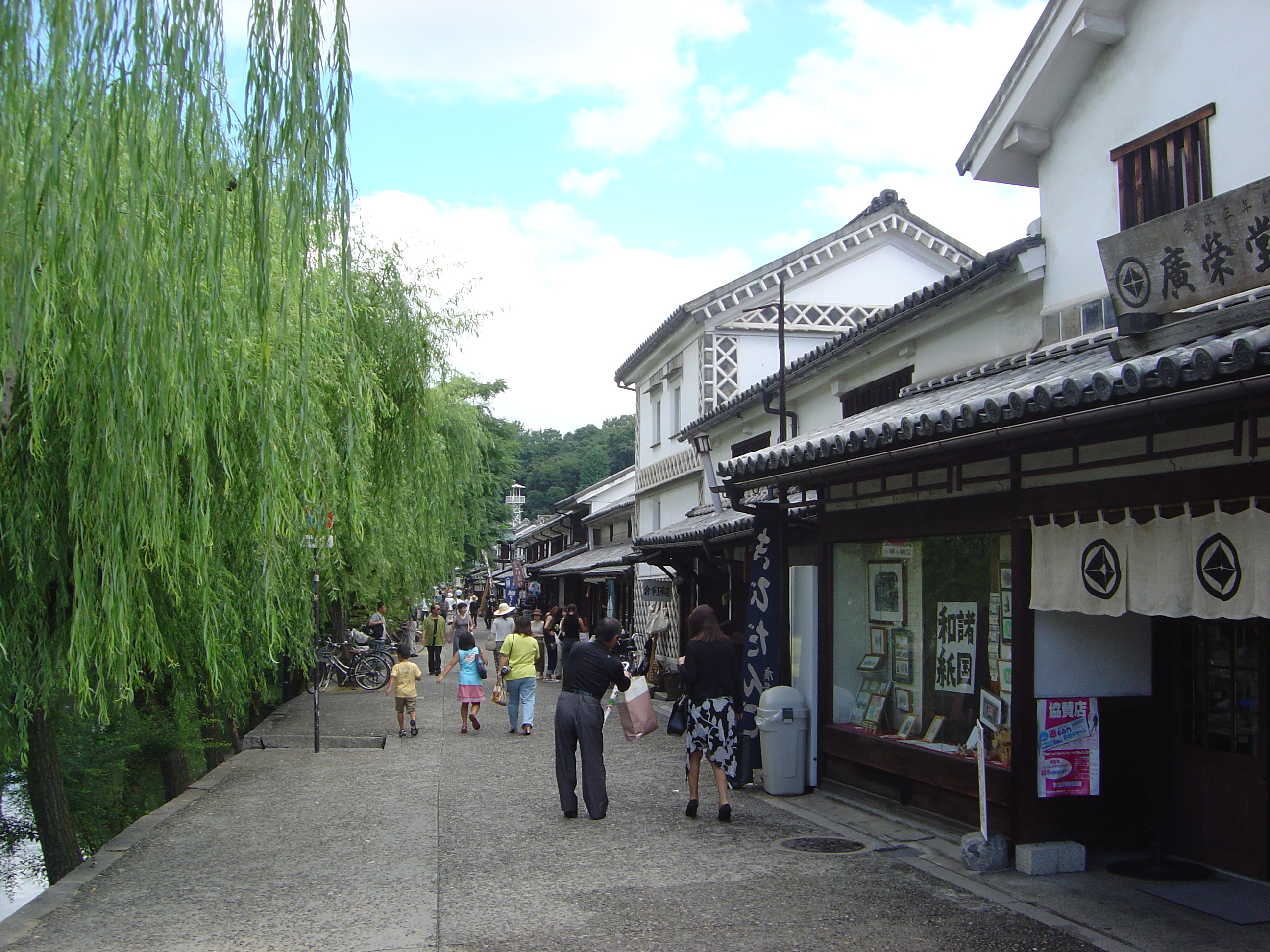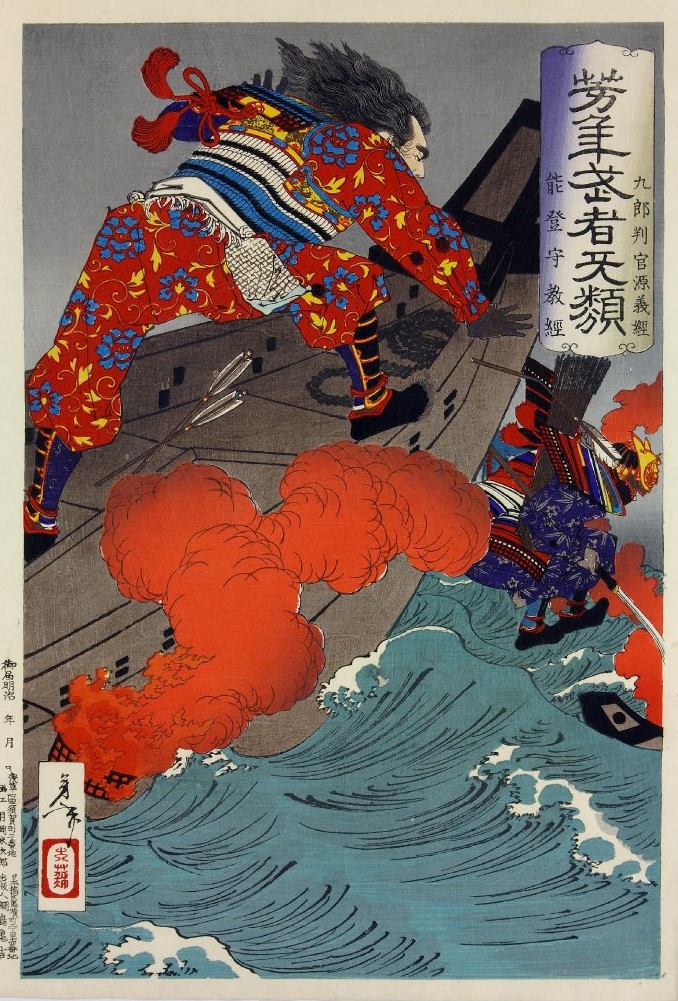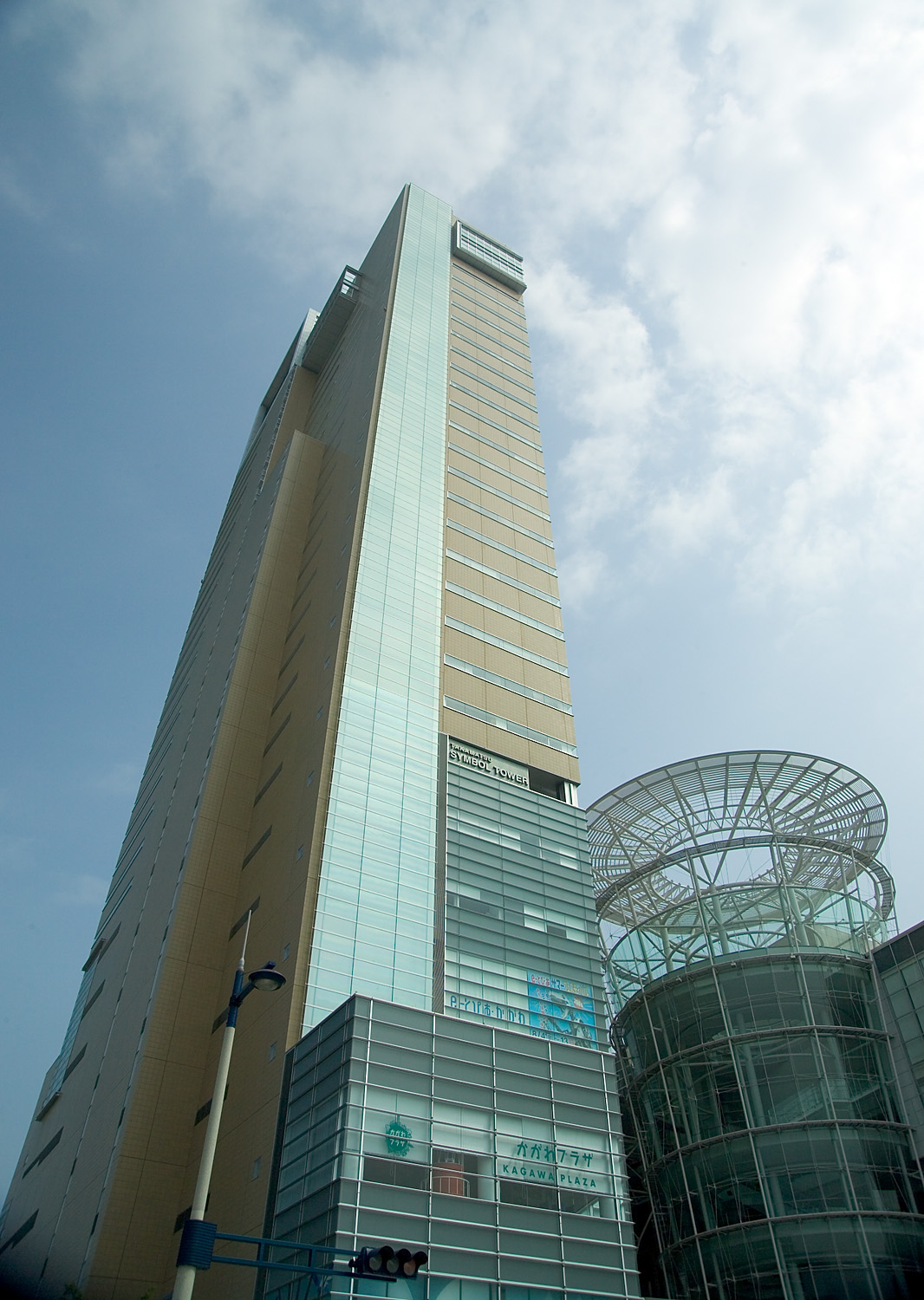|
Battle Of Mizushima
The naval battle of Mizushima took place on 17 November 1183 during the Genpei War. One of the most important bases of the Taira was Yashima, a small island off the coast of Shikoku. In November 1183, Minamoto no Yoshinaka sent an army to cross the Inland Sea to Yashima, but they were caught by the Taira just offshore of Mizushima (水島), a small island of Bitchu Province, just off Honshū. The Taira tied their ships together and placed planks across them to form a flat fighting surface. The battle began with Taira archers loosing a rain of arrows upon the Minamoto boats; when the boats were close enough, daggers and swords were drawn, and the two sides engaged in hand-to-hand combat. Finally, the Taira, who had brought fully equipped horses on their ships, swam to the shore with their steeds, and routed the remaining Minamoto was one of the surnames bestowed by the Emperors of Japan upon members of the imperial family who were excluded from the line of succession an ... [...More Info...] [...Related Items...] OR: [Wikipedia] [Google] [Baidu] |
Genpei War
The was a national civil war between the Taira and Minamoto clans during the late Heian period of Japan. It resulted in the downfall of the Taira and the establishment of the Kamakura shogunate under Minamoto no Yoritomo, who appointed himself as '' Shōgun'' in 1192, governing Japan as a military dictator from the eastern city of Kamakura. It followed a '' coup d'état'' by the Taira in 1179 with the removal of rivals from all government posts, and subsequently banishing them, and a call to arms against the Taira, led by the Minamoto in 1180. The ensuing Battle of Uji took place just outside Kyoto, starting a five-year-long war, concluding with a decisive Minamoto victory in the naval Battle of Dan-no-ura. However, it has been pointed out that the Battle of Ōshū in 1189 was the last battle during this period of civil war, as it completed Yoritomo's nationwide domination through the annexation of Northeast Japan. The name "Genpei" (sometimes romanized as ''Gempei'') ... [...More Info...] [...Related Items...] OR: [Wikipedia] [Google] [Baidu] |
Kurashiki, Okayama
is a historic city located in western Okayama Prefecture, Japan, sitting on the Takahashi River, on the coast of the Inland Sea. As of March 31, 2017, the city has an estimated population of 483,576 and a population density of 1,400 persons per km². The total area is 355.63 km². History The modern city of Kurashiki was founded on April 1, 1928. Previously, it was the site of clashes between the Taira and Minamoto clans during the Heian period. It gradually developed as a river port. During the Edo period, it became an area directly controlled by the shogunate. Distinctive white-walled, black-tiled warehouses were built to store goods. During the Meiji Restoration (Japan's Industrial Revolution period), factories were built, including the Ohara Spinning Mill, which still stands as the nostalgic tourist attraction Ivy Square. On August 1, 2005, the town of Mabi (from Kibi District), and the town of Funao (from Asakuchi District) were merged with Kurashiki. Geography Cli ... [...More Info...] [...Related Items...] OR: [Wikipedia] [Google] [Baidu] |
Taira
The Taira was one of the four most important clans that dominated Japanese politics during the Heian, Kamakura and Muromachi Periods of Japanese history – the others being the Fujiwara, the Tachibana, and the Minamoto. The clan is divided into four major groups, named after the emperor they descended from: Kanmu Heishi, Ninmyō Heishi, Montoku Heishi, and Kōkō Heishi. The clan is commonly referred to as or , using the character's On'yomi for ''Taira'', while means " clan", and is used as a suffix for " extended family". History Along with the Minamoto, Taira was one of the honorary surnames given by the emperors of the Heian Period (794–1185 CE) to their children and grandchildren who were not considered eligible for the throne. The clan was founded when the Imperial Court grew too large, and the emperor ordered that the descendants of previous emperors from several generations ago would no longer be princes, but would instead be given noble surnames ... [...More Info...] [...Related Items...] OR: [Wikipedia] [Google] [Baidu] |
Minamoto
was one of the surnames bestowed by the Emperors of Japan upon members of the imperial family who were excluded from the line of succession and demoted into the ranks of the nobility from 1192 to 1333. The practice was most prevalent during the Heian period (794–1185 AD), although its last occurrence was during the Sengoku period. The Taira were another such offshoot of the imperial dynasty, making both clans distant relatives. The Minamoto clan is also called the , or less frequently, the , using the on'yomi reading for Minamoto. The Minamoto were one of four great clans that dominated Japanese politics during the Heian period—the other three were the Fujiwara, the Taira, and the Tachibana. History The first emperor to grant the surname Minamoto was Minamoto no Makoto, seventh son of Emperor Saga. The most prominent of the several Minamoto families, the Seiwa Genji, descended from Minamoto no Tsunemoto (897–961), a grandson of Emperor Seiwa. Tsunemoto went to ... [...More Info...] [...Related Items...] OR: [Wikipedia] [Google] [Baidu] |
Yada Yoshikiyo
was a Japanese samurai military commander, feudal lord, and courtier in the late Heian period of Japan's history. He took part in the Genpei War as a general for Minamoto no Yoshinaka, leading Yoshinaka's army against the Taira clan at the Battle of Mizushima where he was defeated and perished. His descendants would go on to form the Hosokawa clan and gain influence and power during the Ashikaga Shogunate and the subsequent Sengoku and Edo Periods as Daimyo. Genealogy Although Yoshikiyo was the eldest son of Minamoto no Yoshiyasu, the founder of the Ashikaga clan, he did not inherit his father's estates in Shimotsuke Province following Yoshiyasu's death. Those properties instead went to his younger half-brother Ashikaga Yoshikane whose mother was Yoshiyasu's primary wife. Yoshikiyo's mother is unknown, however, if he was passed over for the succession she likely came from less prestigious origins than Yoshikane's who came from the Fujiwara clan. It was instead his uncle Nitt ... [...More Info...] [...Related Items...] OR: [Wikipedia] [Google] [Baidu] |
Taira No Shigehira
(1158–1185) was one of the sons of Taira no Kiyomori, and one of the Taira Clan's chief commanders during the Heian period of the 12th century of Japan. Following the Battle of Uji in 1180, Shigehira fought in the Siege of Nara, where he burned the monks of the Tōdai-ji monastery. He married Fujiwara no Hoshi (藤原輔子), the second daughter of Dainagon Fujiwara Kunitsuna (藤原邦綱). Shigehira defeated Minamoto no Yukiie at the Battle of Sunomatagawa in 1181. He was captured in 1184 at the Battle of Ichi-no-Tani. He was then turned over to the monks of the Tōdai-ji is a Buddhist temple complex that was once one of the powerful Seven Great Temples, located in the city of Nara, Japan. Though it was originally founded in the year 738 CE, Tōdai-ji was not opened until the year 752 CE. The temple has undergo ... monastery in 1185, and was killed as revenge. References * Turnbull, Stephen (1998). ''The Samurai Sourcebook.'' London: Cassell & Co. 1158 birt ... [...More Info...] [...Related Items...] OR: [Wikipedia] [Google] [Baidu] |
Taira No Tomomori
(1152–1185) was the son of Taira no Kiyomori, and one of the Taira Clan's chief commanders in the Genpei War at the end of the Heian period of Japanese history. He was victorious at the Battle of Uji in 1180. He also became successful in the Battle of Yahagigawa in 1181. Tomomori was again victorious in the naval Battle of Mizushima two years later. At the Battle of Dan-no-ura, when the Taira were decisively beaten by their rivals, Tomomori joined many of his fellow clan members in committing suicide. He tied an anchor to his feet and leapt into the sea. Tomomori has become a popular subject for kabuki plays. Gallery Image:Yoshitoshi The Ghost of Taira no Tomomori.jpg, The ghost of Taira no Tomomori at Daimotsu Bay, in an 1891 print by Tsukioka Yoshitoshi Tsukioka Yoshitoshi ( ja, 月岡 芳年; also named Taiso Yoshitoshi ; 30 April 1839 – 9 June 1892) was a Japanese printmaker. Nussbaum, Louis Frédéric. (2005)"Tsukoka Kōgyō"in ''Japan E ... [...More Info...] [...Related Items...] OR: [Wikipedia] [Google] [Baidu] |
Taira No Noritsune
(1160 – 1185) was a military leader of the late Heian period of Japan. He was the son of Taira no Norimori. He fought in the Genpei War against the Minamoto clan. Genpei War Noritsune was a commander during the Genpei War. He fought in many battles including the battles of Mizushima and Dan-no-ura. He also fought in the Battle of Ichi-no-Tani, and killed Satō Tsugunobu in the Battle of Yashima. Death He committed suicide in the Battle of Dan-no-ura, while holding a Minamoto warrior under each arm plunging into the sea. His father also committed suicide at the same battle. In the play, he is disguised as the priest 'Yokawa no Kakuhan', until he is forced to confess his true identity by Benkei. See also *''The Tale of Heike is an epic account compiled prior to 1330 of the struggle between the Taira clan and Minamoto clan for control of Japan at the end of the 12th century in the Genpei War (1180–1185). Heike () refers to the Taira (), ''hei'' being the ''on'y . ... [...More Info...] [...Related Items...] OR: [Wikipedia] [Google] [Baidu] |
Takamatsu, Kagawa
270px, Takamatsu City Hall 270px, Aerial view of Takamatsu city center 270px, View from Yashima to Takashima port is a city located in Kagawa Prefecture, Japan. , the city had an estimated population of 414,134 in 190120 households and a population density of 1100 persons per km². The total area of the city is . It is the capital city of the prefecture. Geography Takamatsu is located in central Kagawa Prefecture on the island of Shikoku. The city is located in the Takamatsu Plain, which is part of the Sanuki Plain, and is occupied by a gentle slope as a whole. The northern part faces the Seto Inland Sea, forming a semicircular urban area centered on Takamatsu Port and Takamatsu New Port (commonly known as Shinminato).The western part of the city consists of an alluvial fan formed by the sedimentation of the Koto River. The eastern part is a flooded plain formed by the Kasuga River and Shinkawa River. In the northeastern part of the island, there is Yashima, a table-shaped pla ... [...More Info...] [...Related Items...] OR: [Wikipedia] [Google] [Baidu] |
Shikoku
is the smallest of the four main islands of Japan. It is long and between wide. It has a population of 3.8 million (, 3.1%). It is south of Honshu and northeast of Kyushu. Shikoku's ancient names include ''Iyo-no-futana-shima'' (), ''Iyo-shima'' (), and ''Futana-shima'' (), and its current name refers to the four former provinces that made up the island: Awa, Tosa, Sanuki, and Iyo. Geography Shikoku Island, comprising Shikoku and its surrounding islets, covers about and consists of four prefectures: Ehime, Kagawa, Kōchi, and Tokushima. Across the Seto Inland Sea lie Wakayama, Osaka, Hyōgo, Okayama, Hiroshima, and Yamaguchi Prefectures on Honshu. To the west lie Ōita and Miyazaki Prefectures on Kyushu. Shikoku is ranked as the 50th largest island by area in the world. Additionally, it is ranked as the 23rd most populated island in the world, with a population density of 193 inhabitants per square kilometre (500/sq mi). Mountains running east a ... [...More Info...] [...Related Items...] OR: [Wikipedia] [Google] [Baidu] |
Minamoto No Yoshinaka
, , or Lord Kiso was a general from the late Heian period of Japanese history. A member of the Minamoto clan, Minamoto no Yoritomo was his cousin and rival during the Genpei War between the Minamoto and the Taira clans. Yoshinaka was born in Musashi province. His dharma name was Tokuon'in Gisan Senkō (徳音院義山宣公). Early life Yoshinaka's father, Minamoto no Yoshikata, was killed by Minamoto no Yoshihira in 1155. Yoshihira also sought to kill Yoshinaka who escaped to Shinano Province. He was raised by Nakahara Kaneto, Imai Kanehira's father, together with his milk-brother Imai Kanehira, who would later become his best friend and most loyal retainer. Yoshinaka later changed his name from Minamoto to , to reflect the Kiso Mountains where he was raised. Genpei War Yoshinaka accepted Prince Mochihito's call to the Minamoto clan to rise against the Taira in 1181. He entered the Genpei War by raising an army and invading Echigo Province. He then defeated a Taira force ... [...More Info...] [...Related Items...] OR: [Wikipedia] [Google] [Baidu] |





